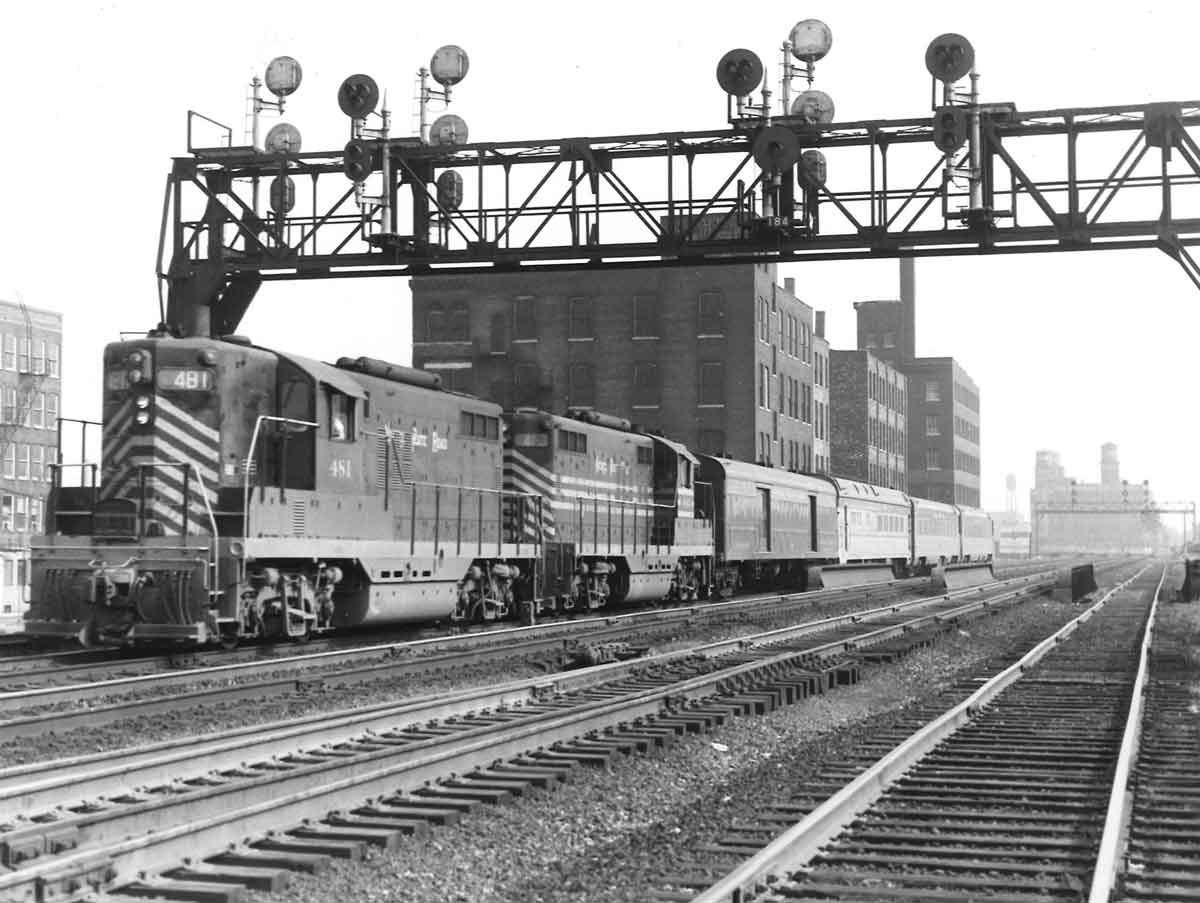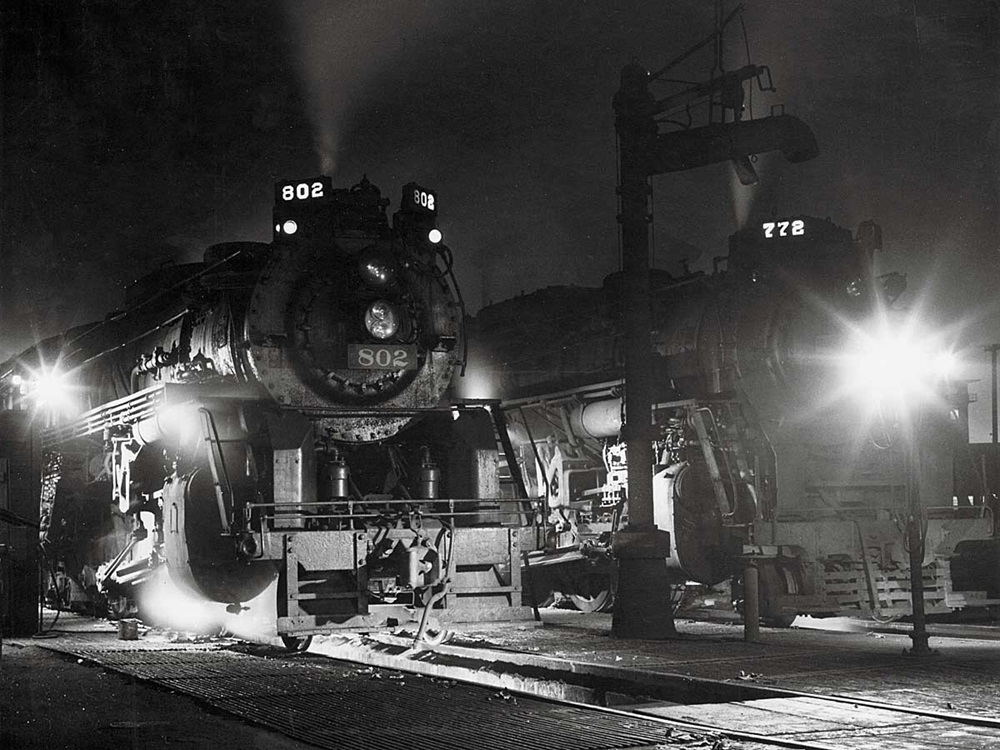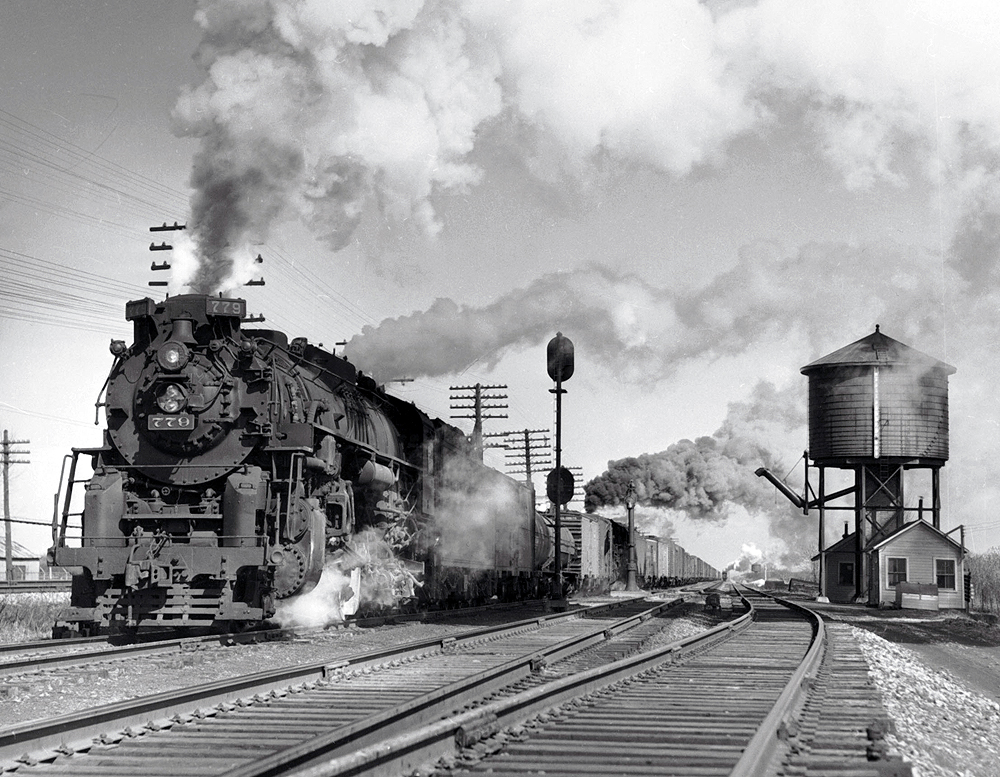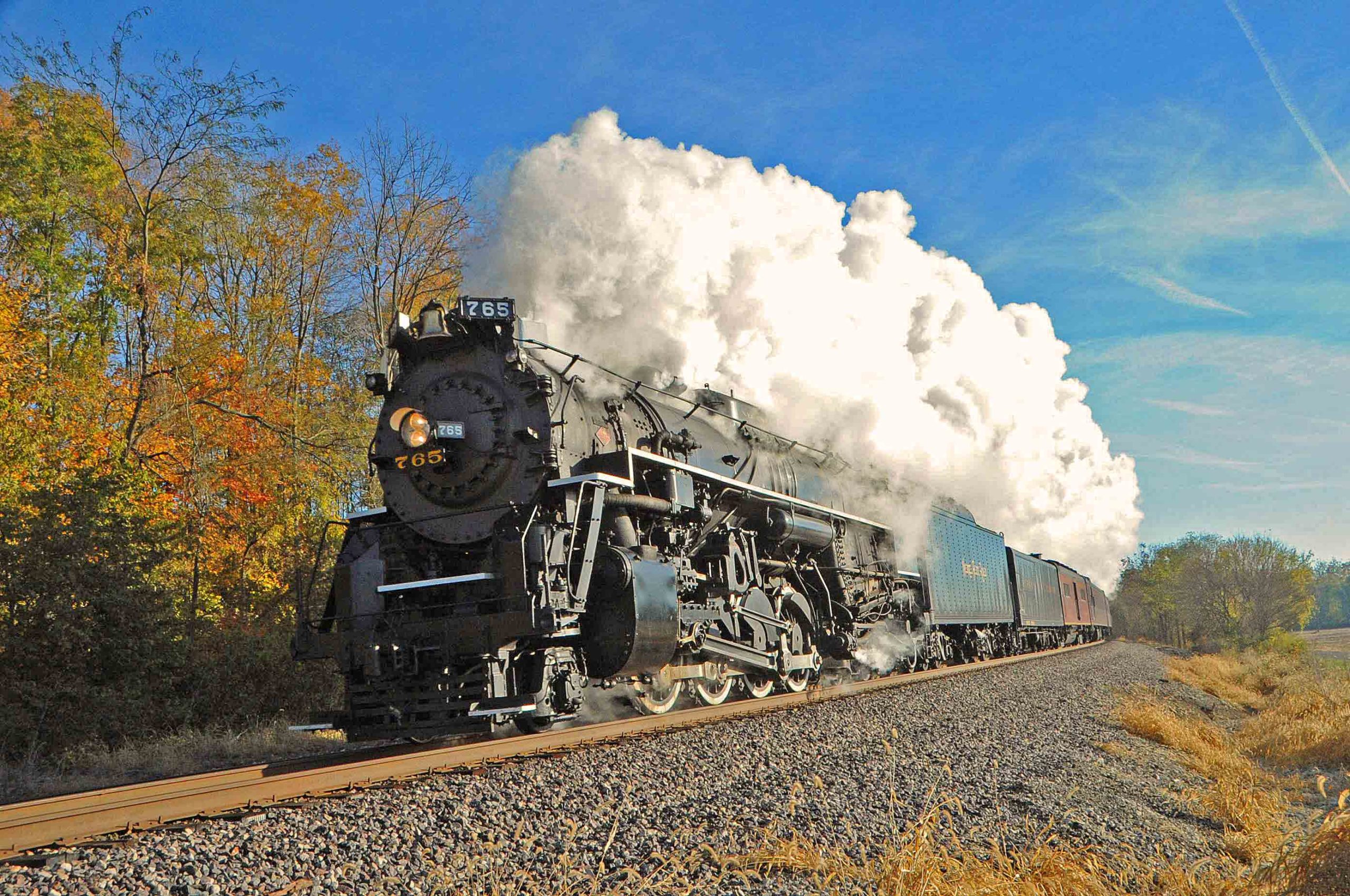In reply to NickD :
It looks like they kept the steering wheel?
In reply to Pete Gossett (Forum Supporter) :
Oh, that is weird. In the first two photos, the vertical orientation in the center of the frame had me thinking maybe it was used for the brakes, like on a freight car. But then, in the third photo, I swear it looks like the guy in the driver's seat is holding the steering wheel and it's angled and offset like a regular steering wheel.
On the previous page I said "The DL&W and NKP interchanged at Buffalo, with the the Nickel Plate even operating out of the Lackawanna Terminal in Buffalo, and the two railroads jointly operated Hoboken-Chicago passenger trains. Not to mention the Lackawanna and Nickel Plate operated numerous run-through freight trains as far back as the 1890s. The Nickel Plate-Lackawanna Dispatch was the preferred route for shippers of fresh meat and dairy products all the up until the 1960s."
There was actually a serious attempt at a DL&W-NKP merger. In the 1950s, the DL&W seemed to be aware of the way that the northeast railroad industry was headed and began making some moves to try and ensure survival. Anthracite had collapsed as a heating fuel source in the thirties, a lot of the milk traffic was being stolen away by over-the-road trucks, and passenger ridership was also vanishing in the face of interstate highways and airlines. So, the DL&W started making moves like, condensing as many engine facilities and passenger terminals with the neighboring Erie as they could.
Circa 1954, the DL&W began talking with the Nickel Plate Road (officially the New York, Chicago & St. Louis) about a merger. The merger had a lot of strong points to it.

The merger had some downsides though.
What ultimately sank the merger though was not operational concerns, but concerns on the NKP from management. The NKP's president was concerned that if the merger went through, he would be ousted and DL&W management placed in charge instead. The NKP was also still pretty hale and healthy at the time, and there were worries that merging with the DL&W would dilute their stock prices, since the DL&W was not doing so well. And then there was worries that the NY state taxes and the commuter services that I mentioned above, would drag the NKP down with it, instead of helping the DL&W back up.
The NKP declined the merger, which then led the DL&W to turn to the Erie about a merger. The NKP then proceeded to fight that merger tooth and nail, because they realized that when the DL&W and Erie merged, the DL&W traffic would now have it's own way to get to Chicago, over the Erie, and they would lose a friendly interchange partner. This got even worse when E-L was looking at closing the DL&W and Erie yards in Buffalo and moving their major yard to East Binghamton. Fortunately for the NKP, the high cost of building a river bridge to bring the Erie main into East Binghamton prevented this from happening and E-L ultimately management decided to use what capital was available to construct a modern joint terminal with the NKP in Buffalo (Bison Yard). This no doubt streamlined operations in Buffalo and saved money; but it was questionable strategically, as it also helped rival NKP (which became part of N&W not long after). A modern central yard in Binghamton would have sped carload traffic to all E-L points, strengthening the E-L's ability to compete in all of its major markets (especially NY-Chicago).
The Nickel Plate Road was also a participant in the "Alphabet Route", which was a coalition of smaller railroads to offer service to Chicago, St. Louis, Pittsburgh, Philadelphia, Baltimore, NYC and Boston as an alternative to the four major systems of the north east: the Pennsylvania Railroad, the New York Central Railroad, the Erie Railroad and the Baltimore & Ohio Railroad. It involved the joint efforts of Nickel Plate Road, the Wheeling & Lake Erie Railroad (later bought up by NKP), the Pittsburgh & West Virginia, the Reading, the Central Railroad of New Jersey, the Western Maryland, the Lehigh & Hudson River, and the New York, New Haven & Hartford.

The Alphabet Route called their priority trains "Alpha-Jets" and touted friendlier, more personalized service and better rates, in exchange for a slower schedule. The Pennsylvania offered 23-hour service between these points with its Truc Train runs, while the Alphabet Route partners offered 34-hour service. Although this did not seem competitive, much of the 11-hour difference was due to departures and arrivals around midnight for the Pennsylvania service, whereas many shippers did not send and receive shipments during the night and thus could accept a mid-evening departure and a mid-morning arrival, as the Alpha-Jet service could provide.
The three major sources of traffic on the Alpha-Jets were
The Alphabet Route started experiencing changes as early as 1949, when NKP took over the Wheeling & Lake Erie, placing that end of the operation under one roof. Then, in '64 the Norfolk & Western took over the NKP and the Pittsburgh & West Virginia, which left the N&W fully in control of the western end of the route. In 1969, the New Haven was rolled up into Penn Central, depriving the Alphabet Route of their route into New England. Norfolk & Western had also gained control of the Erie-Lackawanna and the D&H, and found it easier to move freight from Chicago to New England via their own rails or the E-L's to the D&H and then from there onto the Boston & Maine. The situation was made worse when the Chessie System was created in 1972, which included the integration of the Western Maryland. And then four years later, Conrail engulfed the CNJ, the Lehigh & Hudson River, and the Reading, which sounded the death knell for the Alphabet Route.
Two Nickel Plate Road "Bluebird" Alco PAs pound over the diamond with the New York Central at South Gary, Indiana. The battle-worn #189 and a twin are in charge of the Westerner, a Chicago-Buffalo passenger train. Note the DL&W baggage cars on the head end, indicative of the joint efforts between the two railroads.

In reply to NickD :
Looking at those maps it's incredible how oversaturated with railroads we were.
As far as I know the only section of the Lake Erie & Western district that still exists is the section from Lafayette to Cheneyville, which is owned by the Kankakee, Beaverville & Southern.
Pete Gossett (Forum Supporter) said:Looking at those maps it's incredible how oversaturated with railroads we were.
Pretty much why those big mergers and consolidations of the '60s and '70s had to happen. There wasn't enough traffic to go around for everyone. I seem to recall reading that Iowa, of all states, had the highest rail density in the US at one point, which is kind of mind-blowing. I would have expected Pennsylvania or Illinois, or maybe even New Jersey (look at how many railroads used New Jersey to gain access to New York City). But, nope, Iowa. All the granger roads crisscrossed all over the state going to every piddling small village to serve every farm and grain elevator. It saw mass abandonment in the '50s and '60s though, when you started having the huge combined grain elevators start getting built. I was blown away by the sheer size of the grain elevators I saw when I went up for the NKP #765 trip, and I started nicknaming them "Indiana Skyscrapers".
An NKP GP9 making a light power move with one of the 1300-series cabooses made from an old wooden box car.

Nickel Plate Road L-1a Hudson #173 sits inside the Calumet roundhouse at Chicago, Illinois on August 18th, 1956. By this point, the NKP Hudsons were almost entirely relegated to secondary or tertiary passenger runs, mail trains, light freight, and protection power in the event that one of the Alco PAs came up lame. These curious little 4-6-4s were little more than a USRA Light Pacific with a 4-wheel trailing truck, and were quite small and low-drivered compared to other locomotives of the Hudson wheel arrangement. A little under two years later, on June 1, 1958, NKP #173 made the last revenue run by an NKP Hudson, from Calumet to Ft. Wayne. Calumet roundhouse was also quite interesting, the last roundhouse constructed in the US during the steam era, being built in 1952. Nickel Plate’s last mainline revenue steam run occurred on July 2, 1958, behind Berkshire #746, and 0-8-0 #212 closed out all steam in the Conneaut, Ohio, yard on July 18, 1959, meaning the Calumet roundhouse was really only used for it's intended purpose for 6 years.

NKP #173 going for a spin on the turntable. What's ironic is that the Alco PAs that supplanted the L-1s barely outlasted them. The Hudsons were done by 1958, and the Alco PAs were gone just four years later, traded in for three high-nose Alco RS-36s with steam generators.

Three NKP Berkshires await a call to service that will never come. At the beginning of 1958, the Nickel Plate stated that regular steam service would continue partway into 1959, and that steam locomotives would likely stay on the property and see occasional usage in traffic surges until 1962. The shops at Bellevue and Conneaut were still performing major overhauls, and were even performing an upgrade program where they were installing roller bearing tender trucks, taken from retired ex-W&LE Berkshires and installing them under the tenders of NKP S-1s and S-2s. Just 6 months later, on July 2nd, 1958, Berkshire #746 made a freight run to Bellevue, and was put on standby for a trip the next day. It was not dispatched the next day, and with that, mainline steam on the NKP passed unceremoniously into history. In mid-summer 1958, there were 29 Berkshires stored serviceable, with many having less than 100 miles operation (break-in runs). Four had zero mileage, including #755 and #759 (the #759 was the last engine overhauled at Conneaut). They were all held as "stored serviceable" until August 31, 1960, when all the steam power and facilities were written off the books. Other than a brief blip of 0-8-0 steam switchers in summer '59, steam never returned to the rails for seasonal traffic surges as predicted.
What happened that caused such a rapid turn of fortune? Two things: the C&O ordering a bunch of diesels, and the Recession of '58. The C&O had a large order of diesels being delivered, something like 200 units, and they showed up right as the recession hit. The C&O suddenly had a bunch of new diesels, but not really the traffic to warrant their usage. The C&O decided to lease some of their older power, like GP9s, out to any railroad that was interested. The NKP had new diesels on the way for '59, to fully dieselize their operations, but when the recession sapped a lot of their traffic away, they realized that keeping separate diesel and steam maintenance facilities and staff was to expensive. They decided to lease twenty-five C&O GP7s to put all the remaining steam locomotives into retirement, and that got them by until their own GP9s and RS-11s started to arrive on the property. By then, rail traffic decreased enough that there were never the seasonal surges that warranted pulling the Berkshires out of retirement. NKP began selling, donating and scrapping steam locomotives to get them off the property. Even so, there were still a few of them on the property after the NKP/Wabash/P&WV/N&W merger, with N&W eventually handling the final disposition of some like the #763 and #757.
Of the three here, only the #757 survived. It was originally supposed to be donated to Bellevue, Ohio shortly after retirement. The city of Bellevue struggled to get a display site together though, and the #757 was still sitting at the shops when N&W took over. N&W decided enough was enough, and instead sent it to the Railroad Museum of Pennsylvania, where it became "the forgotten Berkshire", sitting outside decaying and mostly viewed as an outsider by museum staff. In 2017, the Mad River & NKP Museum in Bellevue finally struck a deal with the RRMoPA, and the #757 was moved by Norfolk Southern back to Bellevue, where it has been cosmetically restored and joins an NKP RSD-12 and an NKP GP30.

A Nickel Plate passenger train departs Chicago's LaSalle Street Station in the final days of the Nickel Plate Road. The Alco PAs were retired in 1962, replaced with three Alco RS-36s with high hoods to accomodate steam generators. One of those RS-36s is paired up with a "torpedo tube" Geep as they make for Buffalo. Note the Rock Island passenger cars to the right, the only western road that the NKP had a direct interchange with at Chicago, and the Erie freight house to the left.

"Torpedo Tube" GP9s #481 and #483 arriving at Chicago with the final run of the Westerner on June 3, 1963.

NKP Berkshires loom in the dark at Bellevue. The #772 on the right was part of the final order of Berkshires from Lima Locomotive Works, ending with the #779 in 1949. The #802 was built for the Wheeling & Lake Erie, as their #6402, and then became part of the NKP roster in 1949. The W&LE Berkshires were built to the same basic blueprint as the Nickel Plate and Pere Marquette Berkshires, but had footboards, disc drivers and roller bearing tender trucks. Oddly, despite being the technically superior machines, they were all retired by the NKP before their own Berkshires. NKP did save the roller bearing tender trucks, with intent to reuse them under their own S-1 and S-2 Berkshires, and even installed a few before throwing in the towel on steam

NKP #779, the final steam locomotive ordered by the NKP and the final steam locomotive built by Lima, leaves NH Tower near North East, PA in March 1957. There's a sister Berkshire, cut in five cars back due to bridge weight restrictions, helping the train get moving.

The Nickel Plate's sole GP35 leads two GP9s and two GP18s on a westbound freight at Bellevue. NKP's practice was to replace wrecked units with something from the same manufacturer that was "the nearest applicable model". This resulted in them rostering a single GP35 and a single C420, as replacements for wrecked units.

Working for new owner N&W and traveling on rails that previously belonged to the rival Wabash, GP9 #530 prepares to pound over the Illinois Central diamond at Decatur.

Technically a Norfolk & Western train, ex-NKP Alco RS-36 872 leads ex-Wabash F7A #680, ex-NKP GP9 #812 and ex-NKP RS-11 #563 past State Line Tower at Hammond, Indiana, where it will then cross the EJ&E, N&W (ex-Wabash), and the IHB on July 24, 1965

The Cuyahoga Valley Scenic Railroad ran a limited schedule last year, due to a soil erosion issue that was detected south of the railroad’s Fitzwater Maintenance Yard last October. They had planned to resume full operation on March 3rd, only for that plan to immediately derail, no pun intended, when newly installed geotechnical soil monitors provided data indicating continuing problems along the former Baltimore & Ohio trackage. This has also led to Cuyahoga Valley Scenic to announce that, even if they get back to a regular schedule, they will not be having their Steam In The Valley, where they bring in a steam locomotive for a month or so, typically NKP #765, while they try and get the roadbed issues solved.

Hal Raven, owner of Raven Rail LLC and the Saratoga, Corinth & Hudson, has added another early Alco to his collection of 539-powered Alcos. The new unit, RS-1 #3501, was originally built for Dupont. It then was sold to the Department of Energy for use at the Savannah River Nuclear Plant. Before heading to Savannah River it was overhauled at Chattahooche Locomotive Works, where it had a modern control stand and EMD electrical cabinet retrofitted and the traction motors were overhauled. After years at Savannah River, it was then sold to Huntsville-Madison County Airport Authority in 2004 and used at their International Intermodal Center, along with an ex-LV/CR SW900. Hal Raven purchased the locomotive, went down and inspected it, found it to be in excellent operational condition and had it shipped up to Batten Kill Railroad to replace his ex-D&H S-2 that he moved down to the Saratoga, Corinth & Hudson. It's a really neat machine, and it will be painted in the SC&H green with yellow chevrons and lettering eventually.

It's funny how much smaller it is than modern power.




You'll need to log in to post.